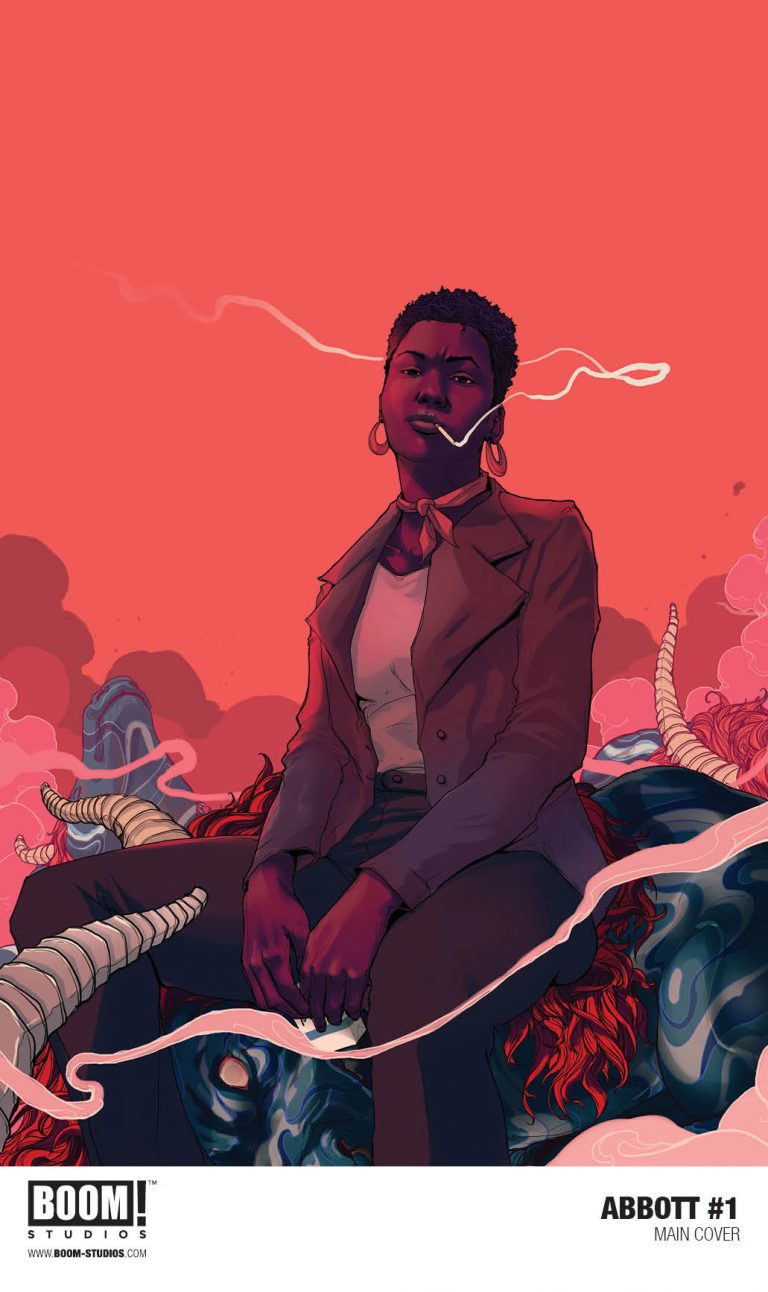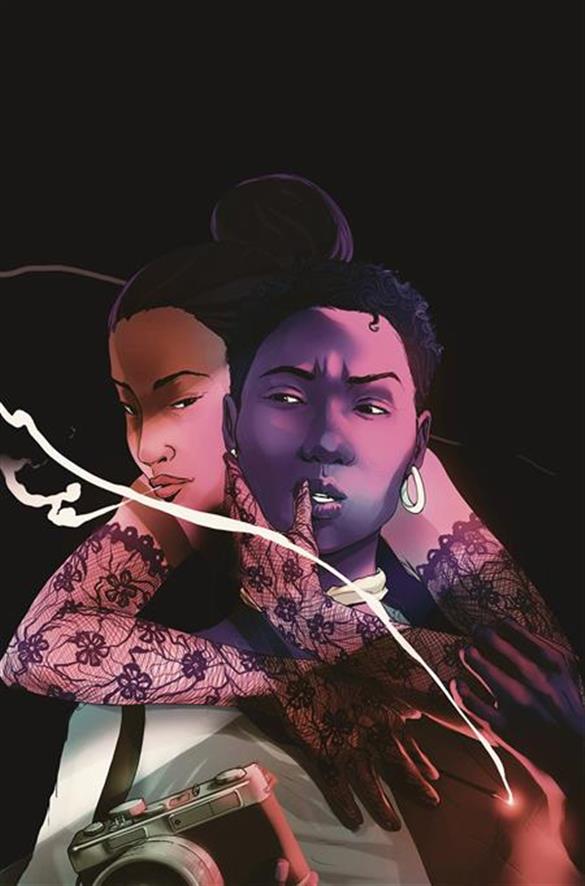Welcome to the latest installment of my comics review column here at Skiffy & Fanty! Every month, I use this space to shine a spotlight on SF&F comics (print comics, graphic novels, and webcomics) that I believe deserve more attention from SF&F readers.
This month, I’m shining a spotlight on a new series that debuted in January, 2018, and that, as I predicted in the Skiffy & Fanty Looking Back, Moving Forward: The 2018 Edition podcast, checks absolutely all my boxes: Saladin Ahmed and Sami Kivelä’s Abbott. (This review contains spoilers!)

ABBOTT #1 and 2
Created and written by Saladin Ahmed
Art by Sami Kivelä
Colors by Jason Wordie
Lettered by Jim Campbell
Cover art by Taj Tenfold
Published by BOOM! Studios
At first, I wasn’t sure that I was going to review Abbott. Not because it isn’t excellent — it is, as I’ll discuss in more detail below. Rather, because my focus is always to, you know, shine that spotlight on works that deserve more recognition, and acclaimed, Hugo-nominated author Saladin Ahmed needs no further introduction to the SF&F community. And so far, Abbott has been both comparatively high-profile and successful. The first printing of the first issue sold out and a reprint was required to meet demand, which from my own time in the independent comics trenches I can tell you does not always happen and is a very good sign.
But that same inside baseball knowledge reminds me that almost every independent comic experiences a significant drop in retailer orders with the second issue, sometimes as much as fifty percent. That kind of drop-off can be hard for new titles from small publishers to weather. And, of course, there are always potentially interested readers who simply didn’t find out about the series through their networks, and who will be surprised to hear it exists. It would be a shame for those readers, or anyone, to miss out on Abbott. It’s worth seeking out.
The series follows Saladin Ahmed’s popular and successful run writing the new Black Bolt series for Marvel. I was delighted to see that his next foray into comics was a creator-owned title from BOOM! Studios. I was very curious to see what the author of Throne of the Crescent Moon would do with a story in comics form that didn’t have to fit within the superhero genre, or the confines of the Marvel Universe.
And I was not disappointed.
It’s Detroit, in 1972, and the city seethes with racial tension. Elena Abbott is a black woman, and a reporter, in trouble with the paper’s white owners and viewed with suspicion by the mostly-white cops for her exposes of murderous police brutality towards a black teenager.
Abbott is smart, uncompromising and utterly implacable in her devotion to discovering and revealing the truth. She’s also traumatized by the loss of her first husband, Samir, apparently some kind of magician upholding the forces of order, who she witnessed being attacked and murdered by literally shadowy agents of mystical chaos called the Umbra.
So when Elena sees signs of the Umbra in the mutilation of a police horse and the horrifying death of a drug addict, she follows the thread in the hopes of finding answers, finding the truth, for herself, for all the concerned friends who thinks she’s dangerously obsessed, and for the world at large.
It’s a dangerous course, and Elena finds herself not only revisiting her past in sad and discomforting ways, but in increasing danger as she comes to the attention of the murderous agents of the Umbra.
Saladin Ahmed has acknowledged, in interviews, that this is a classic set-up, echoing Kolchak the Night Stalker and the X-Files. But there are also important differences. The setting is one — the time and place, the politics and history, play a vital role in the story, and Ahmed evokes them beautifully. There’s a tragic undertone to Elena Abbott’s dogged pursuit of the truth, her valiant battle to overcome the disdain of sexists and to hold bigots accountable for their crimes. But that same sadness, the knowledge of the future and the many battles still to come and justice still unattained that the reader has, serve to underscore Elena’s courage and commitment.
Some reviewers have referred to Elena Abbott a badass, and that’s true, but it could give the wrong impression. Because over the course of the first two issues, Abbott herself has been almost completely non-violent. Even when physically attacked, she escapes with her words or her wits. Elena Abbott is the best kind of badass: She wins because she’s smart, unafraid and her commitment to uncovering the truth is virtually a force of nature. I didn’t realize how ready I was for a heroic investigative reporter story, but I was, and Elena Abbot is that, in abundance.
The story, at least so far, eschews some of the narrative pitfalls common to both urban fantasy (a subgenre that it could be plausibly, if arguably, said to fall within) and the supernatural thriller, specifically what I think of as the bold-investigator-learning-about-weird-stuff type. Those pitfalls lie in plot — a tendency to meander — and in worldbuilding — a tendency for everything to be true.
But Saladin Ahmed is, among other things, a Hugo-nominated writer of epic fantasy; he knows from world-building. The centrality of the forces of chaos and deception in the Umbra, and their opposition by the forces of order and truth, increasingly personified by Elena Abbott, means that I don’t need to worry that the next issue will feature Abbott fighting mad scientists or ravening were-sloths. While I have no doubt that the story will continue to unfold new surprises and new truths as Abbott and the reader discover them, it won’t be a chaotic patchwork, but, fitting with the theme, a map, carefully crafted, that when illuminated, reveals underlying truth and order.
The plot, too, is deftly and efficiently constructed, which is not actually something one necessarily expects from an epic fantasist. But Ahmed is also known for his poetry, his short stories, and now also for his comics writing, all of which are forms that require precision, rigor and narrative compression. And the plot of Abbott is precise and well-crafted indeed. No element is wasted; everything serves multiple purposes. Scenes that seemed to be character-establishing beats, motivation-building backstory, or depictions of Abbott’s ordinary world before her adventure disrupts that life, pay off in present plot as soon as the second issue.
Seriously. I was not expecting the dead horse thing to lead to… well, that.
When a writer throws a lot of balls into the air, it’s always a question whether they’ll drop one or two, drop everything and try to make it look like they did it on purpose, or manage to juggle them all. Two issues in leaves room for me to be wrong, of course, but those two issues have been so smart, so deep, so meticulously constructed, that I feel confident that the juggling is all in aid of a finale that will be very impressive indeed.
Abbott is not perfect. From a narrative standpoint, the biggest drawback is probably the tendency of Ahmed to depict the supporting characters as fairly broad types. This is pretty much mandated, I know, by the same narrative compression that makes the plot tick so effectively — we’re introduced to a pretty sprawling cast in the first issue alone, with more, some of whom appear in issue two, foreshadowed or referred to. And Ahmed does draw his types well, efficiently but with love and care. I’m particularly enamored of Elena’s gruff but supportive editor Fred, who so far seems to be pretty much completely Lou Grant and Perry White mashed up with the good side of J. Jonah Jameson. He’s a type, to be sure, but such a fun depiction of such a fun type that it satisfies. Still, I’m hopeful that as the series continues to unfold, the same craft that makes the story flow so well, and depicts Elena Abbott with such depth and care, will provide us with some more nuance to and surprises from the hard-nosed, hard-drinking cop, the fatherly mentor, and the femme fatale.
The other issue from my standpoint is really quite a small thing, and it’s not a flaw at all, but what could be considered a very minor content warning: Abbott smokes. Like, constantly. Now, there are clear reasons for this, that derive from character, from the place and time, and even as hints of a deeper truth that will be revealed by the unfolding plot. But Abbott smokes constantly. If you, like me, are a bit bothered by people smoking around non-smokers — yes, it was a different time, I get it, but it still reflexively makes my eyes itch — consider this a heads-up.

Sami Kivelä’s art is well-suited to Ahmed’s story, portraying tone, emotion and a sense of place beautifully. This is a Detroit and a 1972 that feel deeply real. The art, and particularly the layouts, give me a strong impression of being influenced by artists like Dave Gibbons and John Totleben, especially their mid-80s work in collaboration with Alan Moore, which is an apt stylistic choice.
The style, however, doesn’t always lend itself well to the depiction of motion, or of action, at least in Kivelä’s hands, and some moments that should express intensity and movement seem a bit too composed and like tableaux. This may be another side-effect of narrative compression; there are a lot of small panels in the comic, which is probably both a deliberate stylistic choice and a sheer necessity in terms of all the narrative ground that has to be covered. But it sometimes doesn’t give the art quite enough room to breathe.
However, in a comic that mostly eschews action, this is a small and forgivable weakness. And Jason Wordie’s colors fit well with Kivelä’s art and contribute adeptly to the sense of time, place and mood.
Two issues of Abbott have been published to date, with the third scheduled to arrive in stores on March 28, 2018. It’s a great opportunity to get caught up on this excellent and engaging series.
Abbott, as I predicted, checks all my boxes. I hope that strong sales continue, and lead to the timely release of a collected volume later this year, and many more stories of Elena Abbott and the creepy beat she covers on the weird side of 1972 Detroit. I’m there for it.
Acknowledgements and Disclosures: I would like to acknowledge that Toronto, and the land it now occupies, where I live and work, has been a site of human activity for 15,000 years. This land is the traditional territory of the Huron-Wendat and Petun First Nations, the Seneca, and most recently, the Mississaugas of the Credit River. The territory was the subject of the Dish with One Spoon Wampum Belt Covenant, an agreement between the Iroquois Confederacy and Confederacy of the Ojibwe and allied nations to peaceably share and care for the resources around the Great Lakes. This territory is also covered by the Upper Canada Treaties. Today, the meeting place of Toronto is still the home to many Indigenous people from across Turtle Island. I am grateful to have the opportunity to live and work in the community of Toronto, on this territory.
I don’t have any personal or professional relationships I’m aware of with the creators or publisher. I purchased my own copies of the comic for review.







